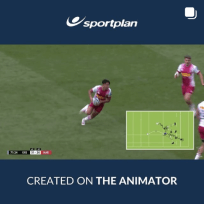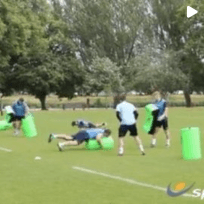Sportplan rugby has played a large role in my team's love for the game!
My fowards seem afraid to ruck and stand around the ruck while in the way of the scrum half trying to get the ball out to the backs. They also don't support the ball carrier while he is being tackled. Please help me with any suggestions!!!
As well as coaching U10 rugby, I also get to referee U10 games, under the New Rules Of Play. I feel that my refereeing of the ruck isn't as good as it could/should be. Has anyone got an easy to follow system to help them referee U10 rucks ?
Simon My son's PE teacher has told him that Bridging is lieegal for the U13 to U19 group. His Club coach has been encouraging its use in games for two seasons. I can see some of the dangers but also the advantages Who is right is it banned or can it be used? Paul submitted by email
Ask a question and have it answered by Coaches from around the world and Sportplan's team of Experts.
Ask a question and have it answered by Coaches from around the world and Sportplan's team of Experts.
Ask a question and have it answered by Coaches from around the world and Sportplan's team of Experts.
Does anyone have good drills for the ruck and how not to over commit players to it, Which players do you want in the ruck when playing crash ball.
a defender that is part of the ruck, can he take a swipe at the ball or tackle the scrumhalf once he has the ball?
Player A tackles the opposing ball carrier (B). His teammate (C) is there to step over the tackled player from an onside position and when Player B attempts to present the ball he reaches down to pickup the placed ball while remaining on his feet. Player B trys to retain the ball because none of his teammates are there to ruck over or pick up the ball. Player C gets called for hands in a ruck. Why? I thought if on my feet and coming through the gate the ball is fair game. I can see only 2 proper/legal ways to get the ball if what I did was a penalty. Option 1 is to step over and kick the ball clear, risking a call for dangerous play, and hoping for the lucky bounce. Option 2 is to step over the carrier AND the ball and hope a teammate is there to pick up or ruck over behind me. Basically, ignoring the ball in plain site and not pick it up. I get it if there are other opposing players (other than the carrier) so a ruck is formed but not the way it happened. What is the right play?
Are you allowed to put your hand into the ruck
I watched a semifinal allblacks vs wallabies, Pocock was penalised twice for leaving his feet at the ruck. I can't see it on tv. What is actually the situation can be happend? Is he accidentally or his leg get stuck in ruck?
Hi im a first time coach and is still getting the hang of how the technical details of the game works the back line is my department and whould like any help i can get to know what drills to do and anything helpfull in the backline im currently coaching for the under 9 and 10
I'm coaching and reffing U11 rugby and one of my players is the definitive 'big lad'. His 'strength' is his size and his power, but last weekend he didn't seem to get reffed fairly. The opposition couldn't tackle him down, one on one and when another two joined in to make a mini maul, that didn't slow him down much either. The ref then let other people join in the (one sided) struggle to tackle him down, which seemed very unfair as A) it's outside the laws of U11 rugby,, B) it makes it nigh on impossible for him to offload, C) when he is brought to ground, he has 4-5 players all over him and he got pinged for 'holding on'. He is a recent arrival to rugby and it was our first game for a couple of months, so the situation hadn't reared his head before. We are keen that he learns all of the core skills of rugby and doesn't get used as a battering ram, but after seeing a pack of hyenas trying to pull down the big fella, something just didn't seem right to me.I'd be grateful for any thoughts and opinions.
My team is having trouble going past the ball when rucking. We are working on body heights and hitting past the ball but any suggested drills would be a great help.
I'm a new player trying to learn to play Scrum half. I have a general idea of how the game works having played back positions a few times. However, I'm confused about one thing (and this might be dumb but bear with me). The thing is, I'm pretty quick. I can usually make it to a ruck before the forwards have fully formed it. When this happens I don't really have a good sense of where to stand in order ot have good access to the ball but also avoid blocking other forwards coming in to ruck. Usually I've already surveyed the field (to my newbie abilities anyway) and made a decision as to what I want to do with the ball, yelled the call on my way to the ruck, etc, so that puts me in a mindset that I REALLY want to be close to the ball so I can make it happen. Should I just keep my distance instead until the ruck is fully formed? Where specifically should I be standing and how quickly should I get there? Thanks!
Can you lift the legs when clearing out the ruck and if so what happens if you take the player off his feet to the ground?
We play a team that does not contest the ruck very often so we seal the ruck by positioning our first Rucker over the tackled player and holding on to his shirt with Wright on feet and butt down. Second guy comes in a no connects with first and seal the ball until it is removed. We have been blown up for bridging when we have no hands on ground or weight forward. Anyone have any ideas On how to explain to the ref we are sealing not bridging?? Asked using Sportplan Mobile App
Rucking - does a ruck end when defending players back off from contact? The "successful/unsuccessful end to a ruck" seems to infer that there are still players in contact. If they are not, does the offside line change?
Is sealing the ball at the tackle and ruck legal again?
Hi, Iâm coaching under 9s next year which involves tackling, mauls, rucks etc. Iâm after advise on what to coach first and the amount of time spent on each area. Added to this Iâve somehow become the lead coach after a couple of coaches stepped down (feeling a little under pressure!) Would anybody be willing to share any sessions so I can plan the first month or so. Cheers

in more ways than one




Here are the 5 ways that you can kickstart your 2025 in the correct way with Sportplan and make this the best coaching year you have had!

How did the Modern Olympics originally begin and why are they so culturally significant today?

The Professionalisation of Netball is changing the game. Here is how it is helping to develop the sport.
Coaches from around the world look to Sportplan for coaching confidence.